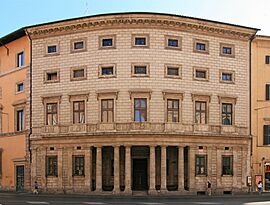Palazzo Massimo alle Colonne facts for kids
Quick facts for kids Palazzo Massimo alle Colonne |
|
|---|---|

Facade of Palazzo Massimo alle Colonne.
|
|
| General information | |
| Location | Rome, Italy |
| Coordinates | Lua error in Module:Coordinates at line 614: attempt to index field 'wikibase' (a nil value). |
The Palazzo Massimo alle Colonne is a beautiful Renaissance palace located in Rome, Italy. It is well-known for its unique curved front and interesting history. This grand building stands out even today on a busy street in the heart of Rome.
Contents
History of Palazzo Massimo
This amazing palace was designed by a famous architect named Baldassarre Peruzzi. He worked on it between 1532 and 1536. The palace was built on the spot where three older palaces once stood. These older buildings belonged to the ancient Roman Massimo family.
Sadly, the original palaces were destroyed by a big fire. This fire happened during a terrible event called the Sack of Rome (1527). After the fire, the Massimo family decided to build a new, grander home.
The curved shape of the palace's front is quite special. It was built this way because its foundations followed the curve of an ancient Roman stadium. This stadium, called the Odeon of Domitian, was built by Emperor Domitian long ago. Today, the palace faces a busy street called Corso Vittorio Emanuele II. It is also close to the church of Sant'Andrea della Valle.
Exploring the Palace Entrance
The main entrance of the Palazzo Massimo alle Colonne is very striking. It has a central porch with six tall columns. These columns are in the Doric order, which is a classic style of ancient Greek architecture. They are arranged in pairs and also as single columns.
Inside the palace, you will find two courtyards. The first courtyard also features a porch with Doric columns. These columns support a beautiful upper balcony, which also has Doric columns. The many columns gave the palace its name, alle Colonne, which means "at the Columns."
The front of the palace is considered a masterpiece of its time. It mixes elegant design with a strong, rough stone look called rustication. The entrance is set back from the street, which is different from many other palaces. For example, the Palazzo Medici in Florence has a more typical flat front.
You might also notice that the windows on different floors have different sizes. They also have unique decorative frames, especially on the third floor. Unlike some older buildings, this palace does not strictly follow the rule of using different column styles on each floor.
On the other side of the palace, facing a small square called Piazzetta de' Massimi, is another building. This is the Palazzetto Massimo, also known as the Palazzetto Istoriato. It has beautiful paintings on its outside walls. For many centuries, this connected building was actually the central post office for Rome. Next to the palace, you can also see the Palazzo di Pirro. This building was constructed by a student of another famous architect, Antonio da Sangallo the Younger.
Inside the Palace
The inside of the Palazzo Massimo alle Colonne is just as impressive as the outside. The ceilings and hallways are decorated with many detailed designs. You can see patterns of rosettes, which are like carved flowers. The ceilings also have a special design called "coffered roofs," which means they have sunken panels.
The ceiling right at the entrance is painted with a beautiful picture called a fresco. This fresco was created by an artist named Daniele da Volterra. It shows scenes from the life of Fabio Massimo. He was believed to be the ancient Roman founder of the Massimo family.
The Palace Chapel
On the second floor of the palace, there is a special chapel. This room is famous for a remarkable event that happened there. On March 16, 1583, a 14-year-old boy named Paolo Massimo was briefly brought back to life in this room. This amazing event was said to be performed by Saint Philip Neri.
Because of this special event, the inside of the palace is open to the public only once a year. This happens every year on March 16th. It's a unique chance to see the beautiful interior of this historic building.

